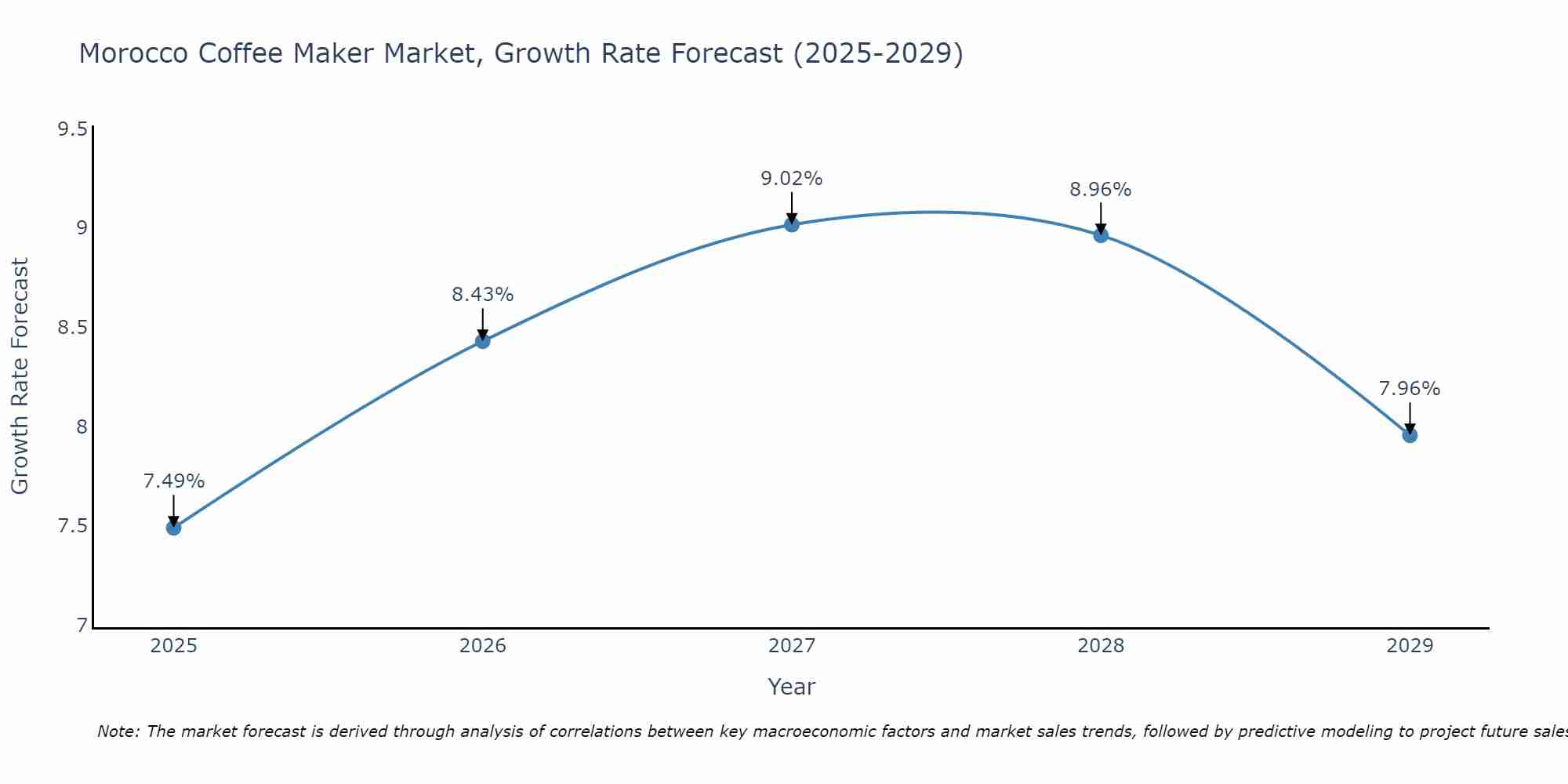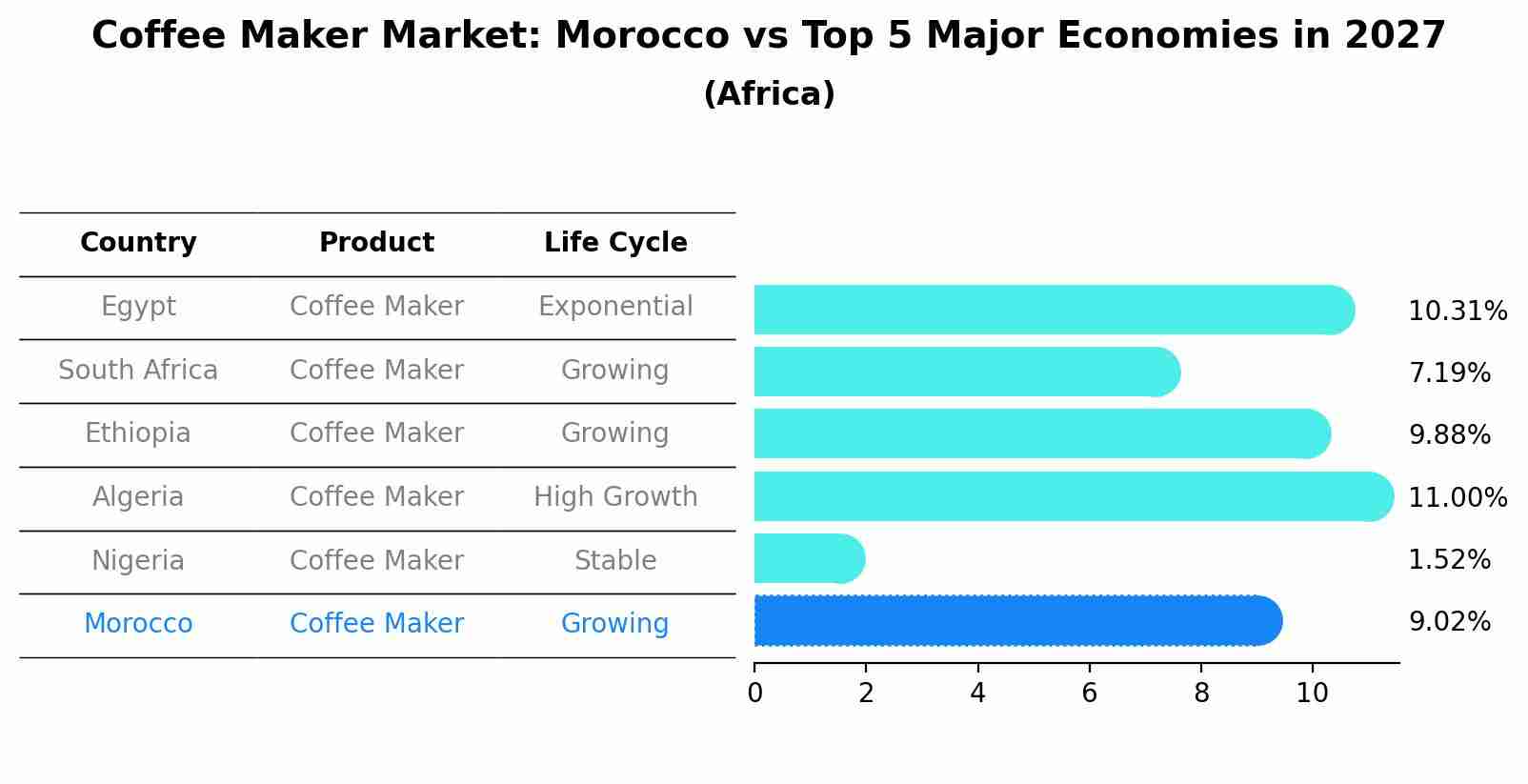Morocco Coffee Maker Market (2025-2031) | COVID-19 IMPACT, Companies, Growth, Revenue, Value, Analysis, Industry, Outlook, Share, Trends, Size & Forecast
| Product Code: ETC013153 | Publication Date: Oct 2020 | Updated Date: Apr 2025 | Product Type: Report | |
| Publisher: 6Wresearch | Author: Ravi Bhandari | No. of Pages: 70 | No. of Figures: 35 | No. of Tables: 5 |
Morocco Coffee Maker Market Size Growth Rate
The Morocco Coffee Maker Market is projected to witness mixed growth rate patterns during 2025 to 2029. Starting at 7.49% in 2025, the market peaks at 9.02% in 2027, and settles at 7.96% by 2029.

Coffee Maker Market: Morocco vs Top 5 Major Economies in 2027 (Africa)
By 2027, Morocco's Coffee Maker market is forecasted to achieve a growing growth rate of 9.02%, with Egypt leading the Africa region, followed by South Africa, Ethiopia, Algeria and Nigeria.

Morocco Coffee Maker Market Synopsis
The coffee maker market in Morocco is expanding rapidly as coffee becomes a staple in daily routines. This market includes a wide range of products from traditional drip coffee makers to advanced espresso machines. The rising number of coffee enthusiasts and the proliferation of coffee shops are significant drivers of market growth. Consumers are seeking convenience, quality, and variety in their coffee makers, prompting manufacturers to innovate with features such as programmable settings, built-in grinders, and milk frothers. This diversification is catering to the diverse preferences of Morocco coffee drinkers.
Drivers of the market
The Morocco coffee maker market is fueled by the growing coffee consumption and the trend towards convenient and efficient coffee brewing solutions. The increasing number of coffee enthusiasts who prefer brewing their coffee at home drives the demand for various types of coffee makers, including espresso machines, drip coffee makers, and French presses. The rise of smart kitchen appliances and the integration of advanced technologies in coffee makers also attract tech-savvy consumers. Furthermore, the expansion of the hospitality industry and the rising number of cafes and restaurants contribute to market growth.
Challenges of the market
The Morocco coffee maker market encounters several obstacles, including high import duties on coffee makers, which increase retail prices and limit affordability for many consumers. There is also a strong preference for traditional coffee preparation methods, which hampers the adoption of modern coffee machines. Additionally, the market faces competition from cheaper, low-quality coffee makers that flood the market, affecting consumer trust and satisfaction. The limited presence of after-sales services and technical support further complicates the situation for consumers who invest in high-end coffee machines.
Government Policy of the market
The Morocco government has supported the growth of the coffee maker market through policies that promote domestic manufacturing and technological innovation. Incentives for local production, such as tax breaks and subsidies, have attracted foreign investments and encouraged the establishment of manufacturing units in Morocco. Furthermore, the government`s efforts to improve the business environment, including streamlined regulatory processes and improved infrastructure, have created favorable conditions for the coffee maker industry to flourish.
Key Highlights of the Report:
- Morocco Coffee Maker Market Outlook
- Market Size of Morocco Coffee Maker Market, 2024
- Forecast of Morocco Coffee Maker Market, 2031
- Historical Data and Forecast of Morocco Coffee Maker Revenues & Volume for the Period 2021-2031
- Morocco Coffee Maker Market Trend Evolution
- Morocco Coffee Maker Market Drivers and Challenges
- Morocco Coffee Maker Price Trends
- Morocco Coffee Maker Porter's Five Forces
- Morocco Coffee Maker Industry Life Cycle
- Historical Data and Forecast of Morocco Coffee Maker Market Revenues & Volume By Types for the Period 2021-2031
- Historical Data and Forecast of Morocco Coffee Maker Market Revenues & Volume By Drip Coffee Machine for the Period 2021-2031
- Historical Data and Forecast of Morocco Coffee Maker Market Revenues & Volume By Steam Coffee Machine for the Period 2021-2031
- Historical Data and Forecast of Morocco Coffee Maker Market Revenues & Volume By Capsule Coffee Machine for the Period 2021-2031
- Historical Data and Forecast of Morocco Coffee Maker Market Revenues & Volume By Others for the Period 2021-2031
- Historical Data and Forecast of Morocco Coffee Maker Market Revenues & Volume By End-users for the Period 2021-2031
- Historical Data and Forecast of Morocco Coffee Maker Market Revenues & Volume By Commercial for the Period 2021-2031
- Historical Data and Forecast of Morocco Coffee Maker Market Revenues & Volume By Industrial for the Period 2021-2031
- Historical Data and Forecast of Morocco Coffee Maker Market Revenues & Volume By Distribution Channel for the Period 2021-2031
- Historical Data and Forecast of Morocco Coffee Maker Market Revenues & Volume By Online for the Period 2021-2031
- Historical Data and Forecast of Morocco Coffee Maker Market Revenues & Volume By Offline for the Period 2021-2031
- Morocco Coffee Maker Import Export Trade Statistics
- Market Opportunity Assessment By Types
- Market Opportunity Assessment By End-users
- Market Opportunity Assessment By Distribution Channel
- Morocco Coffee Maker Top Companies Market Share
- Morocco Coffee Maker Competitive Benchmarking By Technical and Operational Parameters
- Morocco Coffee Maker Company Profiles
- Morocco Coffee Maker Key Strategic Recommendations
Frequently Asked Questions About the Market Study (FAQs):
1 Executive Summary |
2 Introduction |
2.1 Key Highlights of the Report |
2.2 Report Description |
2.3 Market Scope & Segmentation |
2.4 Research Methodology |
2.5 Assumptions |
3 Morocco Coffee Maker Market Overview |
3.1 Morocco Country Macro Economic Indicators |
3.2 Morocco Coffee Maker Market Revenues & Volume, 2021 & 2031F |
3.3 Morocco Coffee Maker Market - Industry Life Cycle |
3.4 Morocco Coffee Maker Market - Porter's Five Forces |
3.5 Morocco Coffee Maker Market Revenues & Volume Share, By Types, 2021 & 2031F |
3.6 Morocco Coffee Maker Market Revenues & Volume Share, By End-users, 2021 & 2031F |
3.7 Morocco Coffee Maker Market Revenues & Volume Share, By Distribution Channel, 2021 & 2031F |
4 Morocco Coffee Maker Market Dynamics |
4.1 Impact Analysis |
4.2 Market Drivers |
4.3 Market Restraints |
5 Morocco Coffee Maker Market Trends |
6 Morocco Coffee Maker Market, By Types |
6.1 Morocco Coffee Maker Market, By Types |
6.1.1 Overview and Analysis |
6.1.2 Morocco Coffee Maker Market Revenues & Volume, By Types, 2021-2031F |
6.1.3 Morocco Coffee Maker Market Revenues & Volume, By Drip Coffee Machine, 2021-2031F |
6.1.4 Morocco Coffee Maker Market Revenues & Volume, By Steam Coffee Machine, 2021-2031F |
6.1.5 Morocco Coffee Maker Market Revenues & Volume, By Capsule Coffee Machine, 2021-2031F |
6.1.6 Morocco Coffee Maker Market Revenues & Volume, By Others, 2021-2031F |
6.2 Morocco Coffee Maker Market, By End-users |
6.2.1 Overview and Analysis |
6.2.2 Morocco Coffee Maker Market Revenues & Volume, By Commercial, 2021-2031F |
6.2.3 Morocco Coffee Maker Market Revenues & Volume, By Industrial, 2021-2031F |
6.3 Morocco Coffee Maker Market, By Distribution Channel |
6.3.1 Overview and Analysis |
6.3.2 Morocco Coffee Maker Market Revenues & Volume, By Online, 2021-2031F |
6.3.3 Morocco Coffee Maker Market Revenues & Volume, By Offline, 2021-2031F |
7 Morocco Coffee Maker Market Import-Export Trade Statistics |
7.1 Morocco Coffee Maker Market Export to Major Countries |
7.2 Morocco Coffee Maker Market Imports from Major Countries |
8 Morocco Coffee Maker Market Key Performance Indicators |
9 Morocco Coffee Maker Market - Opportunity Assessment |
9.1 Morocco Coffee Maker Market Opportunity Assessment, By Types, 2021 & 2031F |
9.2 Morocco Coffee Maker Market Opportunity Assessment, By End-users, 2021 & 2031F |
9.3 Morocco Coffee Maker Market Opportunity Assessment, By Distribution Channel, 2021 & 2031F |
10 Morocco Coffee Maker Market - Competitive Landscape |
10.1 Morocco Coffee Maker Market Revenue Share, By Companies, 2024 |
10.2 Morocco Coffee Maker Market Competitive Benchmarking, By Operating and Technical Parameters |
11 Company Profiles |
12 Recommendations |
13 Disclaimer |
- Single User License$ 1,995
- Department License$ 2,400
- Site License$ 3,120
- Global License$ 3,795
Search
Thought Leadership and Analyst Meet
Our Clients
Related Reports
- Germany Breakfast Food Market (2026-2032) | Industry, Share, Growth, Size, Companies, Value, Analysis, Revenue, Trends, Forecast & Outlook
- Australia Briquette Market (2025-2031) | Growth, Size, Revenue, Forecast, Analysis, Trends, Value, Share, Industry & Companies
- Vietnam System Integrator Market (2025-2031) | Size, Companies, Analysis, Industry, Value, Forecast, Growth, Trends, Revenue & Share
- ASEAN and Thailand Brain Health Supplements Market (2025-2031) | Strategy, Consumer Insights, Analysis, Investment Trends, Opportunities, Growth, Size, Share, Industry, Revenue, Segments, Value, Segmentation, Supply, Forecast, Restraints, Outlook, Competition, Drivers, Trends, Demand, Pricing Analysis, Competitive, Strategic Insights, Companies, Challenges
- ASEAN Bearings Market (2025-2031) | Strategy, Consumer Insights, Analysis, Investment Trends, Opportunities, Growth, Size, Share, Industry, Revenue, Segments, Value, Segmentation, Supply, Forecast, Restraints, Outlook, Competition, Drivers, Trends, Demand, Pricing Analysis, Competitive, Strategic Insights, Companies, Challenges
- Europe Flooring Market (2025-2031) | Outlook, Share, Industry, Trends, Forecast, Companies, Revenue, Size, Analysis, Growth & Value
- Saudi Arabia Manlift Market (2025-2031) | Outlook, Size, Growth, Trends, Companies, Industry, Revenue, Value, Share, Forecast & Analysis
- Uganda Excavator, Crane, and Wheel Loaders Market (2025-2031) | Strategy, Consumer Insights, Analysis, Investment Trends, Opportunities, Growth, Size, Share, Industry, Revenue, Segments, Value, Segmentation, Supply, Forecast, Restraints, Outlook, Competition, Drivers, Trends, Demand, Pricing Analysis, Competitive, Strategic Insights, Companies, Challenges
- Rwanda Excavator, Crane, and Wheel Loaders Market (2025-2031) | Strategy, Consumer Insights, Analysis, Investment Trends, Opportunities, Growth, Size, Share, Industry, Revenue, Segments, Value, Segmentation, Supply, Forecast, Restraints, Outlook, Competition, Drivers, Trends, Demand, Pricing Analysis, Competitive, Strategic Insights, Companies, Challenges
- Kenya Excavator, Crane, and Wheel Loaders Market (2025-2031) | Strategy, Consumer Insights, Analysis, Investment Trends, Opportunities, Growth, Size, Share, Industry, Revenue, Segments, Value, Segmentation, Supply, Forecast, Restraints, Outlook, Competition, Drivers, Trends, Demand, Pricing Analysis, Competitive, Strategic Insights, Companies, Challenges
Industry Events and Analyst Meet
Whitepaper
- Middle East & Africa Commercial Security Market Click here to view more.
- Middle East & Africa Fire Safety Systems & Equipment Market Click here to view more.
- GCC Drone Market Click here to view more.
- Middle East Lighting Fixture Market Click here to view more.
- GCC Physical & Perimeter Security Market Click here to view more.
6WResearch In News
- Doha a strategic location for EV manufacturing hub: IPA Qatar
- Demand for luxury TVs surging in the GCC, says Samsung
- Empowering Growth: The Thriving Journey of Bangladesh’s Cable Industry
- Demand for luxury TVs surging in the GCC, says Samsung
- Video call with a traditional healer? Once unthinkable, it’s now common in South Africa
- Intelligent Buildings To Smooth GCC’s Path To Net Zero


















